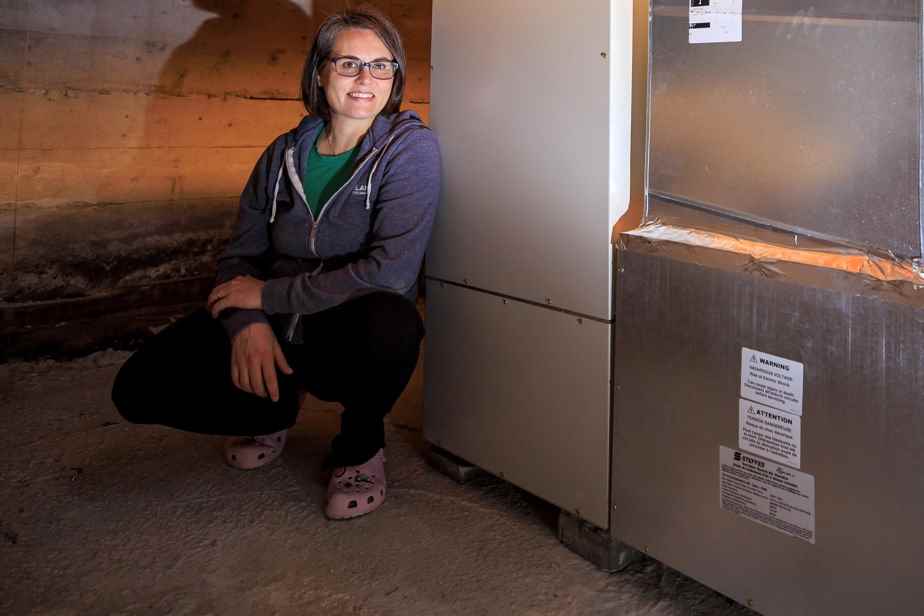Leila Hynninen and Radu Mara could no longer bear to have a fuel oil tank in their basement in Pierrefonds. A generous grant of $10,000 offered by Hydro-Québec encouraged them to adopt a new type of central heating, with a heat accumulator.
Posted at 12:00 p.m.
They benefited from additional financial assistance of $5,000 from the government corporation, by having an Energy Star-certified central heat pump installed at the same time. And they took advantage of the financial assistance paid under the Chauffez vert program.
“Oil-fired heaters are doomed,” says Leila Hynninen, who has two young children, 3 years and 7 months. “The new device is so much smaller, it fits in the crawl space. I almost won a new room in the basement. »

PHOTO ALAIN ROBERGE, THE PRESS
Radu Mara and Leila Hynninen plan to take advantage of the space that has been freed up in their basement by the disappearance of their old oil furnace. For ecological and economic reasons, they are proud to have opted for a new type of central heating, with a heat accumulator.
The very principle of the new system, which includes high-density ceramic bricks that store heat to heat the house at certain times, appeals to him very much.
It’s an old concept that has been modernized. We used to heat stones and put them in our bed. As a kid, I did this with my rabbit hoping to warm him up in his cage.
Leila Hynninen
“It must be said that my family is of Finnish origin. For us, it’s natural to heat stones in a sauna and extract the very high heat they contain,” she continues.
Thanks to the subsidies, the system and the heat pump came to roughly the same price as a traditional solution, while offering other advantages, including the possibility of reducing the electricity bill, notes her husband, Radu Mara.
A solution to the winter peak
The central heating system with heat accumulator was introduced in the Montreal region three years ago as part of a pilot project overseen by Hydro-Quebec. “The heat storage devices were then twice as big,” says Jean-Sébastien Beauchesne, vice-president of the company Géoservices. The new Serenity system from the manufacturer Steffes, which was developed with Hydro, is easier to install and less expensive. »
According to him, there are about 75 systems (of both models) in the province. By the end of the year, 100 Serenity models should find buyers, estimates Martin Carrier, marketing consultant at Hydro-Québec. This number will increase as new heating specialists are trained throughout Quebec.
What contributed to feed the reflection, it is the arrival of the dynamic pricing, which makes it possible to value the displacement of the consumption in one day and to save on our electricity bill.
Martin Carrier, Marketing Advisor, Hydro-Québec
“The famous winter peak is very problematic for Hydro-Québec. With various programs, we really want to be proactive in getting people to change the way they use electricity,” says Mr. Carrier.
Écohabitation, which produced the video training for heating specialists, encourages owners of a fossil fuel heating appliance to opt for a central heating system with a heat accumulator.
“In all our calculations and all our scenarios, when we calculate the subsidy, it is the most economical choice, reveals Emmanuel Cosgrove, general manager of the non-profit organization. It is also the most ecological choice, because when we are at peak, we import dirty electricity. People also consume a lot of gas, with a dual-energy system, when it is -12°C and below. Greenhouse gas emissions remain significant. This represents half a ton of GHGs annually, for a single typical bungalow. »
To facilitate the replacement of fossil fuel heating systems, Écohabitation is preparing a financial loan program with municipalities. This could be launched in the spring of 2023.
Heat accumulators in brief
What’s this ?
Programmed to consume electricity outside peak periods – from 6 a.m. to 9 a.m. and from 4 p.m. to 8 p.m. – the device accumulates heat using ceramic bricks. As the electrical elements stop working, less electricity is consumed without compromising comfort. This is advantageous for subscribers to the Flex D rate. The credit can be around $200 per year without having to do anything.
Who is the target clientele?
Mainly owners of a fossil fuel or dual-energy central heating system, due in particular to the year of construction of the dwellings and their energy efficiency. Nothing prevents other owners from taking an interest in it, specifies a Hydro-Quebec spokesperson, “but the financial advantages are less important for them and the recovery of the investment will be longer”. Financial assistance does not apply to new constructions. The Efficient Heat Pumps program is then offered.
Until when ?
Until June 30, 2023, Hydro-Québec pays a subsidy of $10,000 to owners who have a central heating system with a heat accumulator installed. An additional $5,000 is paid if an Energy Star certified central heat pump is also installed. Note that as of December 31, 2023, it will be prohibited to replace an oil heater with anything other than an electric heater.
Costs and Subsidies
Oil-to-electric conversion work, with accumulator and heat pump: approximately $28,750 (approximately $25,000 + tax)
Subsidies : $16,275 ($10,000 for the heat accumulator + $5,000 for the heat pump + $1,275 for the Chauffez vert program)
Net cost: approximately $12,475
Oil-to-electric conversion work with heat accumulator WITHOUT heat pump: approximately $20,700 (approximately $18,000 + tax)
Subsidies : $11,275 ($10,000 for the heat accumulator + $1,275 for the Chauffez vert program)
Net cost: around $9425
Source: Geoservices

